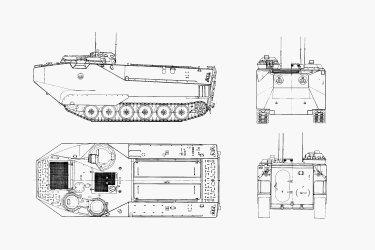



The LVTP-7 (later re-designated AAV7) is the latest in a long tradition of amphibious assault vehicles whose origins stretch back to World War II. The massive boat shaped hull is built of welded aluminum and can carry a total of 25 fully armed marines in a rear troop compartment that is accessible through a power-operated ramp (overhead hatches are also built in for dismounting or for loading supplies). Armament is provided by a 12.7-mm M85 machine gun located behind the driver's station to the right of the vehicle. Amphibious capability is provided through a pair of water jets at the rear and does not require preparation before being launched from an assault ship towards its inland objectives. Additionally, it can be propelled through the movement of its tracks while afloat if needed. The LVTP-7 has now been in service with the USMC for four decades, and has seen action during the 1982 Grenada invasion, the Gulf War, the Somali intervention, and the Iraq War. Export clients include Argentina, Brazil, Chile, Italy, Japan, Spain, South Korea, Taiwan, Thailand, Venezuela, Indonesia of which Argentinean units were used during the taking of the Falkland Islands in April 1982 (but later retired back to the mainland). Despite its age and deficiencies in its armor protection, it is yet to be replaced.
Development began in 1966 and the first prototype was completed the following year as the LVTPX12. It entered service as the LVTP-7 in 1972 after which an improved variant known as the LVTP-7A1 was introduced into service. This featured a new turret that added a 40-mm grenade launcher to complement the M85 machine gun. Additionally, it was fitted with a new engine, smoke generators, passive night vision, and improved electric systems. Shortly afterwards, it was decided to re-designate it as the AAV7 and further structural improvements as part of a Service Life Extension Program (SLEP) resulted in the AAV7A1 which has received numerous other incremental upgrades over the years including appliqué armor. Other variants include the AAVC7A1 command vehicle, the AAVR7A1 recovery vehicle while others have a mine plough added.
Preceded by:
LVTP-5 (1956)Succeeded by:
None |  | |
| Design | LVTP-7 | AAV7A1 |
| Type | Amphibious Assault | Amphibious Assault |
| Year | 1972 | 1986 |
| Crew | 3 | 3 |
| Dimensions | ||
| Length (w/Gun) | 8.16 m | 8.16 m |
| Width | 3.270 m | 3.270 m |
| Height | 3.310 m | 3.310 m |
| Ground Clearance | 0 m | 0 m |
| Track | 0 m | 0 m |
| Track on Ground | 0 m | 0 m |
| Weight | ||
| Combat | 22,838 kg | 25,261 kg |
| Empty | 17,441 kg | 19,100 kg |
| Ground Pressure | 0 kg/cm² | 0 kg/cm² |
| Suspension | Tube-over-bar | Tube-over-bar |
| Performance | ||
| Speed (Off-Road) | 64 km/h | 72 km/h |
| Range (Off-Road) | 482 km | 482 km |
| Amphibious | Yes (14 km/h) | Yes (13 km/h) |
| Vertical Obstacle | 0.91 m | 0.91 m |
| Trench | 2.44 m | 2.44 m |
| Gradient | 60% | 60% |
| Powerplant | ||
| Engine | 1 x 400-hp Detroit Diesel 8V-53T | 1 x 400-hp Cummins VT400 |
| Fuel | Diesel | Diesel |
| Power/Weight | 17.51 hp/t | 15.83 hp/t |
| Armament | ||
| Main | 1 x 12.7-mmM85Machine Gun↑ 60° / ↓ -15° / ↔ 360° | 1 x 12.7-mmM85Machine Gun↑ 45° / ↓ -8° / ↔ 360° |
| Secondary | None | None |
| Ammo | 12.7-mm: 1,000 | 12.7-mm: 1,000 |
| Armor | ||
| Type | Aluminum | Aluminum |
| Thickness | 13 - 45 mm | 13 - 45 mm |
| Max Effective | 45 mm RHAe | 45 mm RHAe |
| Hull Upper Front | 45 mm | 45 mm |
| Hull Lower Rear | 12.7 mm | 12.7 mm |
| Production | ||
| Built | 971 | 1,234 |
| Total | 1,561 |